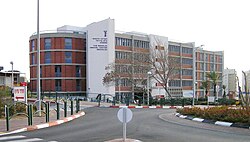Barzilai Medical Center: Difference between revisions
add |
No edit summary |
||
| Line 5: | Line 5: | ||
The hospital opened in July 1961, and was initially named '''Ashkelon Hospital'''. Construction was financed by the Ministry of Health with the assistance of the South-African Zionist Federation, the Ashkelon municipality and [[Mifal HaPayis]]. The building was designed by the architect David Anatol Brutzkus, covering an area of 8000 sq. m. In 1971, it was renamed for [[Health Minister of Israel|Minister of Health]] [[Yisrael Barzilai]], who laid the cornerstone of the building in the early 1960s. <ref>[http://www.barzilaimc.org.il/eng/?CategoryID=207 Barzilai Medical Center history]</ref> |
The hospital opened in July 1961, and was initially named '''Ashkelon Hospital'''. Construction was financed by the Ministry of Health with the assistance of the South-African Zionist Federation, the Ashkelon municipality and [[Mifal HaPayis]]. The building was designed by the architect David Anatol Brutzkus, covering an area of 8000 sq. m. In 1971, it was renamed for [[Health Minister of Israel|Minister of Health]] [[Yisrael Barzilai]], who laid the cornerstone of the building in the early 1960s. <ref>[http://www.barzilaimc.org.il/eng/?CategoryID=207 Barzilai Medical Center history]</ref> |
||
Barzilai Hospital serves a population of 500,000, including a large number of Ethiopian and Russian immigrants. It has 100,000 admissions annually.<ref>[http://njjewishnews.com/njjn.com/041008/sxSteadyRain.html Steady rain of missiles strains Israeli hospital]</ref>Situated six miles from [[Gaza]], it has been the target of numerous [[Qassam]] rocket attacks, sometimes as many as 140 over one weekend. The hospital pays a vital role in treating wounded soldiers and terror victims. <ref>[http://njjewishnews.com/njjn.com/041008/sxSteadyRain.html Steady rain of missiles strains Israeli hospital]</ref> |
Barzilai Hospital serves a population of 500,000, including a large number of Ethiopian and Russian immigrants. It has 100,000 admissions annually.<ref>[http://njjewishnews.com/njjn.com/041008/sxSteadyRain.html Steady rain of missiles strains Israeli hospital]</ref>Situated six miles from [[Gaza]], it has been the target of numerous [[Qassam]] rocket attacks, sometimes as many as 140 over one weekend. The hospital pays a vital role in treating wounded soldiers and terror victims. <ref>[http://njjewishnews.com/njjn.com/041008/sxSteadyRain.html Steady rain of missiles strains Israeli hospital]</ref> |
||
Plans to build a new rocket and missile-proof emergency room for the hospital have been hampered by [[Haredi]] protests sparked by the discovery of human remains in an ancient burial ground unearthed during construction activities. <ref>[http://www.jpost.com/HealthAndSci-Tech/Health/Article.aspx?id=171302 Don't budge Barzilai bones]</ref> |
|||
==References== |
==References== |
||
Revision as of 16:55, 10 October 2010

Barzilai Medical Center (Hebrew: מרכז רפואי ברזילי, Merkaz Refu'i Barzilai) is a 490-bed hospital in Ashkelon in southern Israel.
The hospital opened in July 1961, and was initially named Ashkelon Hospital. Construction was financed by the Ministry of Health with the assistance of the South-African Zionist Federation, the Ashkelon municipality and Mifal HaPayis. The building was designed by the architect David Anatol Brutzkus, covering an area of 8000 sq. m. In 1971, it was renamed for Minister of Health Yisrael Barzilai, who laid the cornerstone of the building in the early 1960s. [1]
Barzilai Hospital serves a population of 500,000, including a large number of Ethiopian and Russian immigrants. It has 100,000 admissions annually.[2]Situated six miles from Gaza, it has been the target of numerous Qassam rocket attacks, sometimes as many as 140 over one weekend. The hospital pays a vital role in treating wounded soldiers and terror victims. [3]
Plans to build a new rocket and missile-proof emergency room for the hospital have been hampered by Haredi protests sparked by the discovery of human remains in an ancient burial ground unearthed during construction activities. [4]
References
